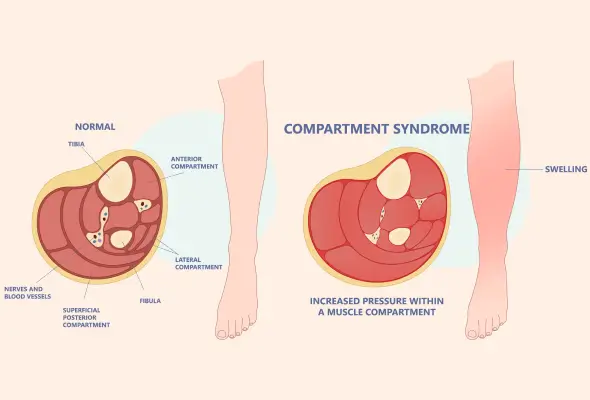-
Doctors
-
Specialities & Treatments
Centre of Excellence
Specialties
Treatments and Procedures
Hospitals & Directions HyderabadCARE Hospitals, Banjara Hills CARE Outpatient Centre, Banjara Hills CARE Hospitals, HITEC City CARE Hospitals, Nampally Gurunanak CARE Hospitals, Musheerabad CARE Hospitals Outpatient Centre, HITEC City CARE Hospitals, Malakpet
HyderabadCARE Hospitals, Banjara Hills CARE Outpatient Centre, Banjara Hills CARE Hospitals, HITEC City CARE Hospitals, Nampally Gurunanak CARE Hospitals, Musheerabad CARE Hospitals Outpatient Centre, HITEC City CARE Hospitals, Malakpet Raipur
Raipur
 Bhubaneswar
Bhubaneswar Visakhapatnam
Visakhapatnam
 Nagpur
Nagpur
 Indore
Indore
 Chh. Sambhajinagar
Chh. SambhajinagarClinics & Medical Centers
Book an AppointmentContact Us
Online Lab Reports
Book an Appointment
Consult Super-Specialist Doctors at CARE Hospitals

Acute Limb Ischemia
Acute Limb Ischemia
Acute Limb Ischemia Treatment in Hyderabad
Acute limb ischemia is a condition in which there is a sudden decrease in blood flow to the limbs, especially in the extremities. Partial or complete occlusion of the arterial supply to the limbs can lead to rapid ischemia and poor function of the limb within a matter of hours.
CARE Hospitals offer all-encompassing diagnostic and treatment services using state-of-the-art infrastructure equipped with the latest technology to perform minimally invasive procedures on patients with a wide spectrum of diseases and medical needs. Our multidisciplinary team of doctors and care providers offer end-to-end care to every patient keeping their needs in mind for the overall improvement of the health and safety of the patients. It goes without saying, you will be taken care of while seeking Acute Limb Ischemia Treatment in Hyderabad at CARE Hospitals.

Causes
Acute limb ischemia causes can be divided into three broad categories:
-
Embolisation: This is the most common reason for limb ischemia where a thrombus from a proximal source travels distally to occlude an artery causing blockage to the flow of blood. The original thrombus source may be post-MI mural-thrombus, abdominal aortic aneurysm, or prosthetic heart valves.
-
Thrombosis in situ: In this type of condition, the atheroma plaque in the artery ruptures and a thrombus forms on the spot.
-
Trauma: This is a less common cause of acute limb ischemia and may include compartment syndrome as a cause.
Other common causes of acute limb ischemia include left ventricular wall thrombosis following myocardial infarction (heart attack), cardiac/aortic tumor, and atrial fibrillation.
Symptoms
The signs and symptoms of acute limb ischemia are described using the six Ps:
-
Pain
-
Pallor
-
Pulselessness
-
Paresthesia (tingling and numbness)
-
Perishingly cold
-
Paralysis
This condition is often characterized by a sudden onset of these symptoms. Late admission to the hospital for the acute limb ischemia treatment can result in irreversible damage to the neuromuscular structures leading to paralysis of the affected limb. Other symptoms of acute limb ischemia can be attributed to the following:
-
Chronic limb ischemia
-
Atrial fibrillation
-
Recent myocardial infarction (MI)
-
Abdominal or back pain
-
Peripheral aneurysms
Diagnosis
Our cardiovascular specialists and cardiologists take immense care to provide proper diagnosis of the patients based on the physical health of the patient and the severity or progress of limb ischemia. Diagnosis may be done based on medical history, visual examination, and other diagnostic tests.
-
Doppler ultrasound scan: Doppler ultrasound using vascular ultrasonography of the peripheral arterial pulse may be performed followed by a contrast CT angiography.
-
Computed Tomography (CT) angiography: CT angiography using contrast dye can be performed to examine the whole body for locating embolisms as well as to determine the range of the occluded site and locate the source of the embolus.
Other tests can be done to identify the cause and evaluate the overall general health of the patient using electrocardiography, thoracoabdominal radiography, urine and blood analysis, and echocardiography.
Treatment
Acute limb ischemia is a surgical emergency. The main goal of acute limb ischemia treatment may be to preserve the affected limb. Complete arterial occlusion may lead to irreversible tissue damage. CARE Hospitals provides the acute limb ischemia treatment in Hyderabad by a team of board-certified cardiovascular surgeons who work together with cardiologists and other healthcare specialists to deliver the best results as quickly as possible without further damage. Heparin therapy may be administered, however, in advanced cases, surgical intervention may be required.
When limb ischemia is caused by an embolic event, several surgical interventions can be considered:
- Embolectomy: This is a surgical procedure aimed at physically removing the embolus (blood clot or other material) that is blocking blood flow in an artery. It is typically performed using a catheter or a surgical incision directly into the artery to clear the blockage. Embolectomy is often the first-line treatment for acute embolic limb ischemia and is highly effective in restoring circulation if performed early.
- Local Intraarterial Thrombolysis: This involves the administration of clot-dissolving drugs (thrombolytics) directly into the affected artery through a catheter. Medications such as tissue plasminogen activator (tPA) are used to break down the embolus, allowing blood flow to return to the limb. This method is especially useful when the embolus is too large or widespread to be removed surgically.
- Bypass Surgery: In cases where the embolus has severely damaged the artery or when embolectomy and thrombolysis are not viable, bypass surgery may be necessary. This involves creating a new route for blood flow around the blocked artery using a graft from another blood vessel or a synthetic tube. Bypass surgery is a more invasive option but can be lifesaving, especially in advanced cases of limb ischemia.
When limb ischemia is due to a thrombotic disease (where blood clots form within the arteries themselves), the surgical treatment options vary slightly:
- Angioplasty with Stenting: This minimally invasive procedure involves using a balloon-tipped catheter to widen the narrowed artery. Once the artery is widened, a stent (a small metal mesh tube) is placed to keep it open, ensuring that blood can flow freely through the vessel. Angioplasty is often combined with the use of clot-dissolving drugs and is commonly used in thrombotic limb ischemia.
- Local Intraarterial Thrombolysis: Similar to its use in embolic events, this method involves administering clot-dissolving drugs directly to the site of the thrombus. It can be particularly effective in thrombotic ischemia, where clots develop gradually and are more likely to respond to medication rather than surgery alone.
- Bypass Surgery: For more advanced cases of thrombotic ischemia, bypass surgery may be required. This technique creates an alternative path for blood to flow around the blocked area, allowing oxygenated blood to reach the affected limb. Bypass surgery is a more extensive procedure but can prevent the progression of ischemia and potential limb loss.
If limb ischemia advances to an irreversible stage, limb amputation may be required.
Long Term Management
Reducing cardiovascular mortality risk is crucial for this patient group. Key strategies include encouraging regular physical activity, quitting smoking, and promoting weight loss when necessary.
Most patients should be initiated on an antiplatelet medication, such as low-dose aspirin or clopidogrel, or possibly anticoagulants like warfarin or a DOAC. It is important to manage any underlying conditions contributing to acute limb ischemia, such as uncontrolled atrial fibrillation.
For cases leading to amputation, occupational and physiotherapy will be essential, along with a comprehensive long-term rehabilitation plan, possibly involving transfer to an intermediate rehab center.
Complications
The most important complication of acute limb ischemia is reperfusion injury in which there is a sudden increase in capillary permeability. This may result in:
- Compartment syndrome
- Release of substances from the damaged muscle cells, such as - K+ ions causing hyperkalemia, H+ ions causing acidosis, Myoglobin resulting in significant AKI
Acute limb ischemia has a mortality rate of around 20%, therefore, it is necessary to monitor for reperfusion syndrome which may require haemofiltration.
Prevention
Reduction of cardiovascular mortality risk is the most important thing to keep in mind for patients with acute limb ischemia. Regular exercise, quitting smoking, and sometimes weight loss may be necessary. Any underlying predisposing condition that may lead to acute limb ischemia in the future should be treated.
Patients undergoing amputation require occupational physiotherapy which may be guided by our experienced physiotherapists. A long-term rehabilitation plan may also be required for such patients to cope with post-surgical activities as well as how they may be feeling.
Post-op recovery and follow-up care
Post-operative recovery and follow-up care for Acute Limb Ischemia (ALI) involve these steps:
- Immediate Care: After surgery to restore blood flow:
- You'll be closely monitored in a recovery area or ICU.
- Medications will be given to manage pain and prevent clotting.
- Monitoring: Continuous checks on vital signs and the affected limb's condition to ensure blood flow is restored.
- Wound Care: Careful management of surgical wounds to prevent infection.
- Physical Therapy: Rehabilitation may start to regain strength and mobility in the affected limb.
- Follow-up Appointments: Regular visits to your doctor to monitor healing and check for any recurrence of ischemia.
- Medication and Lifestyle: Take prescribed medications and make lifestyle changes (like quitting smoking) to improve vascular health.
Our Doctors
-

Dr. Tarun Gandhi
MS, FVES
Vascular & Endovascular Surgery
View More -

Dr. P C Gupta
MBBS, MS, FICA, FIVS (Japan)
Vascular & Endovascular Surgery
View More -

Dr. Ashish N Badkhal
MBBS, MS, MCh
Vascular Surgery
View More -

Dr. Ashok Reddy Somu
MBBS, MD, FVIR
Vascular & Interventional Radiology
View More -

Dr. B. Pradeep
MBBS, MD, DNB, FRCR CCT (UK)
Vascular & Interventional Radiology
View More -

Dr. Gnaneswar Atturu
MBBS, MS, DNB, MRCS, FRCS, PgCert, Ch.M, F.I.P.A, MBA, PhD
Vascular & Endovascular Surgery
View More -

Dr. Mustafa Razi
MBBS, MD
Vascular & Interventional Radiology
View More -

Dr. N. Madhavilatha
MBBS, MS, PDCC
Vascular & Endovascular Surgery
View More -

Dr. Radhika Malireddy
MBBS, DNB (General Surgery), DrNB (Plastic & Reconstructive Surgery), Post-Doctoral Fellowship in Diabetic Foot Surgery
Vascular & Endovascular Surgery
View More -

Dr. Rahul Agarwal
MBBS, DNB (General Surgery), FMAS, DrNB (Vasc. Surg)
Vascular & Endovascular Surgery
View More -

Dr. Rajesh Poosarla
MBBS, MD, DNB, DM (Gold Medalist), EBIR, FIBI, MBA (HA)
Interventional Radiology
View More -

Dr. S. Chainulu
MBBS, DNB (Radio-Diagnosis)
Vascular & Interventional Radiology
View More -

Dr. Santhosh Reddy K
MBBS, MD
Radiology
View More -

Dr. Surya Kiran Indukuri
MBBS, MS (General Surgery), DrNB (Vascular & Endovascular Surgery)
Vascular & Endovascular Surgery
View More -

Dr. Suyash Agrawal
MBBS, General Surgery (DNB), Surgical Oncology (DrNB)
Vascular & Endovascular Surgery
View More -

Dr. V. Apoorva
MBBS, MS (General Surgery), DrNB Vascular surgery
Vascular & Endovascular Surgery
View More -

Dr. Vamsi Krishna Yerramsetty
MBBS, DNB, FIVS
Vascular & Endovascular Surgery
View More -

Dr. Venugopal Kulkarni
MBBS, MS, MRCS, FRCS
Vascular & Endovascular Surgery
View More
Frequently Asked Questions
Still Have a Question?

